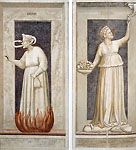That’s right folks, I finally went somewhere while being here. What can I say, it cost money to travel. But, as I sit here eating Nutella and biscotti, I realized that I forgot to write yesterday. I know how important I am in all of your lives (note the desperation in my voice) so I wanted to fix it. As part of my Art History class here, we went to Padova to see the Scrovegni Chapel, the interior of which is completely decorated by Giotto’s frescos. These works reveal a lot about the style of the time, the skill of the best artists around, and the politics circling the pre-medieval world. I would also like to get this out of the way before introducing the subjects, just as a disclaimer. I don’t really like early middle ages art and all of the stuff up through the Gothic period. I enjoy learning about it, about the different developments and styles that were happening, about the masterpieces and great artists. But as art, it is not pleasing to me. I find the use of gold very gaudy and I prefer profound allegory to obvious symbolism. Whew! Now that we have that out of the way I can tell you about how I respect these works for what they are.
This chapel, painted in 1303, was donated by Enrico degli Scrovegni. His family, guilty of being usurers (loansharks) were in danger of eternal damnation, and so to save them and he built this chapel in the name of his late father. In order to show that he was repenting for his sins, he had Giotto depict a series of stories and symbols related to sin and redemption, and he placed the opposing symbols of vices and virtues across from each other.

The real masterpieces, however, are those that line the upper portions of the walls. There are three series of reliefs. They follow three bible stories; that of Mary’s parents, that of Joseph and Mary, and that of the Passion. These frescos were made in the period of Giotto’s maturity, and because of their time, they are true masterpieces and incredible proof of the development of depth and light in art stiles.
Though the perspective had not been invented yet, it is possible to see how Giotto has learned to show depth. It may not be perfect, but you are able to see how the hands on the chapel in the first picture appear behind and in front of the house. Or in the second picture how the outstretched arms of the lamenting man actually depict space. I know this sounds kind of silly, it kind of is, but for this period this was new and incredible. The idea of real space and true forms was becoming popular, and artists like Giotto were the first to master these concepts. Movement also became part of the style, which you can see in most of the figures, and especially the angels flying overhead. Trust me, these were the new big thing. Although he is not my favorite, I do like the fact that he stopped using so much gold in everything. Thank you Giotto!

And that’s enough of your art history lesson for today. I’m wondering, do you think food counts as art? I think so. I think for next week I’ll try and find some really interesting and artistic food to write about. It is Italy after all. I eat all the time here. It’s great, but it’s getting ridiculous!
Ciao ciao!
Danny Fob
Your Wolverine Abroad Blogger

